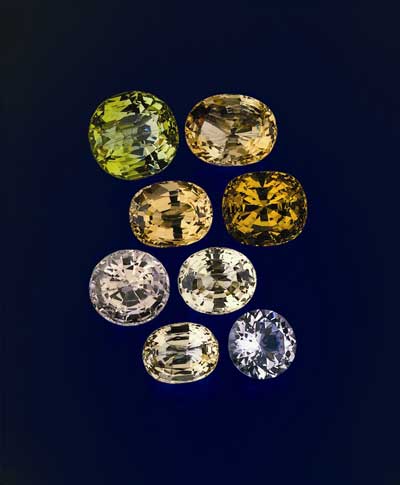| Crystal system | Orthorhombic |
| Transparency | Transparent |
| Luster | vitreous to greasy |
| Fracture | Uneven to Conchoidal |
| Cleavage | None |
| Specific Gravity | 3.00 |
| Hardness | 7 |
| Optical Character | Biaxial + ; Double Refractive |
| Refractive index | 1.630-1.636 |
| Birefringence | 0.006 |
| Dispersion | 0.016 |
| Fluorescence | Light color |
| Pleochroism | |
| Chemical Formula | CaB2(SiO4)2 |
| Comments | |
| Streak | White |
Danburite (DAN-burr-ite) is a calcium borosilicate, having the formula CaB2(SiO4)2. Topaz occurs in similar prismatic orthorhombic crystals, and has about the same refractivity as danburite. Although this mineral has the requisite hardness (7) and brilliancy to be attractive as a gemstone, it suffers from a lack of definite colors; it is found almost exclusively in colorless to pale yellow forms. Slightly deeper yellows are sometimes encountered, however, in which case it becomes a more attractive stone. The name is derived from Danbury, Connecticut, where it was first found with microcline and oligoclase in dolomite. It has since been found in Japan, Burma and Madagascar.
Danburite is transparent to translucent, has no direction of easy cleavage, and the fracture breaks are uneven to sunconcoidal. The streak is white, and the luster is vitreous to greasy. No typical inclusions have been noted. The R.I. is 1.630 - 1.636 and the dispersion is about .016. Some specimens fluoresce a light color under ultraviolet light. The specific gravity is 3.00. Optic character is biaxial positive or negative. The mineral is fusible before the jeweler's torch or the blowpipe but is not attacked by acids.
Because danburite's R.I, is in the same range as topaz and there is little difference in the birefringence (.008 for topaz against .006 for danburite), it is rather difficult to distinguish from topaz by optical methods. There are, however, in addition to danburite's usual fluorescence, two means by which it may be distinguished readily. One of these is specific gravity: it floats in 3.32 liquid and topaz sinks. Using monochromatic light or a filter with the refractometer, it is easy to see that topaz gives a strongly positive sign, whereas the intermediate index of danburite is exactly at the midpoint between the extremes. The middle index of topaz, because it is positive in sign, is closer to the low index; in the case of topaz, it is only about .001 from the lower reading.
Transparent stones are faceted; recommended angles for the crown being 43° and those for the pavilion 39°. Linde A powder on a tin lap produces a satisfactory polish. Since danburite is not heat sensitive and cleavage presents no problem, it is an easy mineral to cut and polish.


